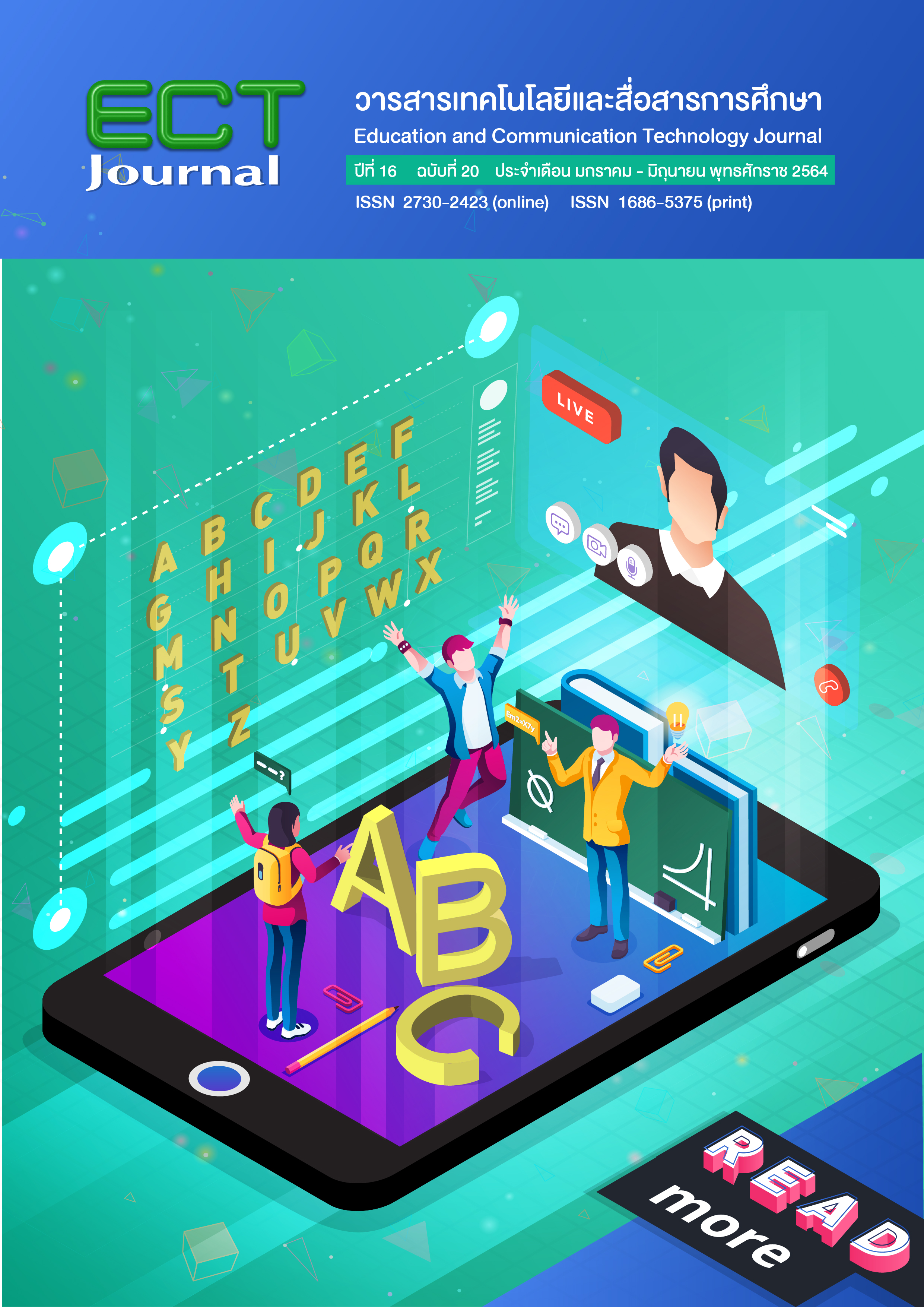Blended Learning Design in Communicative English Language Teaching for Learners in Higher Education in the Digital Age
Keywords:
Instructional Design, Blended Learning,, Communicative English Language TeachingAbstract
The purpose of this academic paper was to study the concepts of instructional design and blended learning in communicative English language teaching for learners in a higher education level. The study was conducted by analyzed and synthesized on documents and research papers related to instructional design, blended learning, and Communicative Language Teaching. The components of blended learning instructional model that are synthesized from this study consist of five components as follows:
1) an instructor and learners, 2) the student-centered learning activities approach, 3) technology and digital media, 4) interaction, and 5) assessment and feedback. The five steps of blended learning instructional model for communicative English language teaching that are synthesized from this academic paper are as follows: 1) presentation, 2) practice, 3) production, 4) wrap up, and 5) assessment and feedback. It is synthesized that practice stage is best suited to be in an online learning because of learning English for communication each learner needs time to practice and develop language skills. This is because in the online training, students can practice repeatedly without time limit. production stage is best suited to be in a face-to-face learning because learners must be able to apply and create their own knowledge. Each learner has developed differently and need help, advice, further explanation differently. Therefore, to assist each learner to increase the language proficiency for communication, the production stage is more suitable to be held in the classroom than online.
References
จิรารัตน์ ประยูรวงษ์. (2562). DIGITAL LEARNING การเรียนรู้ภาษาอังกฤษบนโลกดิจิทัลในศตวรรษที่ 21. วารสารบัณฑิตศึกษา มหาวิทยาลัยราชภัฏวไลยอลงกรณ์ ในพระบรมราชูปถัมภ์, 13(1), 210-223. https://so01.tci-thaijo.org/index.php/VRUGradJour/article/view/183868
จิรัชญา โคศิลา, ประดินันท์ หงสปรีชา, ประกอบ กรณีกิจ, และพร้อมภัค บึงบอน. (2563). ผลการใช้เครื่องมือประเมินผลออนไลน์ระหว่างเรียนเพื่อส่งเสริมผลสัมฤทธิ์ทางการเรียนวิชาภาษาอังกฤษของนักเรียนระดับชั้นมัธยมศึกษาในจังหวัดฉะเชิงเทรา โดยนักศึกษาสาขาวิชาการสอนภาษาอังกฤษชั้นปีที่ 4. วารสารเทคโนโลยีและสื่อสารการศึกษา, 15(19), 15-29. https://so01.tci-thaijo.org/index.php/EDMKU/article/view/248267
ธีรวดี ถังคบุตร. (2555). การศึกษาสมรรถนะการใช้คอมพิวเตอร์และเทคโนโลยีการสื่อสารของนักศึกษาปริญญาบัณฑิตเพื่อพัฒนารูปแบบการเรียนการสอนแบบผสมผสาน. ใน การประชุมวิชาการระดับชาติด้านอีเลิร์นนิง บูรณาการการเรียนรู้ออนไลน์ประชาคมอาเซียน: นโยบายและกระบวนการ (น. 63-37). https://www.elearning.nectec.or.th/eLearningV2/Uploads/elearning2012/Fullpaper/e-learning2012_Fullpaper_1.pdf
ปรัชญนันท์ นิลสุข และปณิตา วรรณพิรุณ. (2556). การจัดการเรียนรู้แบบผสมผสาน: สัดส่วนการผสมผสาน. วารสารพัฒนาเทคนิคศึกษา, 25(85), 31-36. https://journal.fte.kmutnb.ac.th/journal/article-view?id=188
ประกอบ กรณีกิจ และจินตวีร์ (มั่นสกุล) คล้ายสังข์. (2556). รูปแบบอีเลิร์นนิงแบบผสมผสานโดยใช้บันทึกสะท้อนการเรียนรู้แบบมีปฏิสัมพันธ์ออนไลน์ที่ส่งเสริมความใฝ่รู้และความคงทนในการจำของนิสิตคณะครุศาสตร์ จุฬาลงกรณ์มหาวิทยาลัย. วารสารครุศาสตร์, 41(3), 66-82. https://so03.tci-thaijo.org/index.php/EDUCU/article/view/51326
สิริกร บำรุงกิจ, สันติ วิจักขณาลัญฉ์, และธูปทอง กว้างสวาสดิ์. (2562). รูปแบบการเรียนการสอนภาษาอังกฤษด้วยการเรียนรู้แบบผสมผสานเพื่อส่งเสริมทักษะการสื่อสาร. วารสารวิจัยมหาวิทยาลัยขอนแก่น (ฉบับบัณฑิตศึกษา) สาขามนุษยศาสตร์และสังคมศาสตร์, 7(2), 59-70. https://so03.tci-thaijo.org/index.php/gskkuhs/article/view/161499
สุมาลี ชัยเชื้อ. (2561). การใช้สื่อสังคมออนไลน์ในการเรียนแบบผสมผสาน. วารสารครุศาสตร์อุตสาหกรรม, 17(3), 214-221. https://so03.tci-thaijo.org/index.php/JIT/article/view/173761
Bautista, C. V. G. R., Borda, P. B. L. B., Malave, R. O. D., & Gonzalez, S. M. G. R. (2020). A blended learning system in EFL for improving listening and speaking competence. Journal of Alternative Perspectives in the Social Sciences, 10(3), 673-690. https://doi.org/10.15405/ejsbs.266
Horn, M. B., & Staker, H. (2011). The rise of K-12 blended learning. Innosight Institute. https://www.christenseninstitute.org/wp-content/uploads/2013/04/The-rise-of-K-12-blended-learning.pdf
Lalima, K. L., & Dangwal, K. L. (2017). Blended learning: An innovative approach. Universal Journal of Educational Research, 5(1), 129-136. https://doi.org/10.13189/ujer.2017.050116
Lee, G., & Wallace, A. (2018). Flipped learning in the English as a foreign language classroom: Outcomes and perceptions. TESOL Quarterly, 52(1), 62-84. https://doi.org/10.1002/tesq.372
Lyst, C. (2020, July 20). Coronavirus: What is a blended model of learning? BBC News. https://www.bbc.com/news/uk-scotland-52412171
Manurung, N. G., Manurung, K., Mertosono, R. S., & Kamaruddin, A. (2020). Perceptions of EFL learners in the implementation of blended learning post-natural disaster at a university in Indonesia. Theory and Practice in Language Studies, 10(8), 959-968. https://doi.org/10.17507/tpls.1008.15
Olivares, J. (2020). The enhancement of English-speaking ability of the visually impaired students using blended learning. วารสารวิชาการ มหาวิทยาลัยราชภัฏอุดรธานี, 8(1), 56-62. https://ph01.tci-thaijo.org/index.php/udonthanirajabhat/article/view/242288
Parker, T., & Balci, E. (2020). A study on the experiences of students and instructors in blended instruction and learning in an English preparatory school. International Online Journal of Education and Teaching, 7(4), 1709-1729. https://iojet.org/index.php/IOJET/article/view/996
Richards, J. C. (2006). Communicative language teaching today. Cambridge University Press. https://www.cambridge.org/elt/techniques/
Serrano, D. R., Dea-Ayuela, M. A., Gonzalez-Burgos, E., Serrano-Gil, A., & Lalatsa, A. (2019). Technology-enhanced learning in higher education: How to enhance student engagement through blended learning. European Journal of Education, 54(2), 273-286. https://doi.org/10.1111/ejed.12330
Sharma, P. (2010). Blended learning. ELT Journal, 64(4), 456-458. https://doi.org/10.1093/elt/ccq043
Thu My, N., & Minh, H. T. (2020). Information technology freshmen' attitudes towards English language learning with blended learning course at FPT Polytechnic College. International Journal of Scientific and Research Publications, 10(8), 665-670. https://doi.org/10.29322/IJSRP.10.08.2020.p10485
VijayaKumar, S., & Viswanathan, R. (2018). Performance analysis in blended and online classrooms: An experimental study. CALL-EJ, 19(2), 100-124. http://callej.org/journal/19-2/Vijayakumar-Viswanathan2018.pdf
Visser, P., & Sukavatee, P. (2020). Effects of the genre-based writing instructional module in a blended learning environment. Journal of Education Naresuan University, 22(2), 1-17. https://so03.tci-thaijo.org/index.php/edujournal_nu/article/view/240798
Wang, Y. (2020). A study on college English high-efficiency class based on blended teaching mode of flipped classroom. Theory and Practice in Language Studies, 10(9), 1066-1071. https://doi.org/10.17507/tpls.1009.06
Wu, W. V., Hsieh, J. S. C., & Yang, J. C. (2017). Creating an online learning community in a flipped classroom to enhance EFL learners' oral proficiency. Educational Technology & Society, 20(2), 142-157. https://www.jstor.org/stable/jeductechsoci.20.2.142
Downloads
Published
How to Cite
Issue
Section
License
Copyright (c) 2021 มหาวิทยาลัยสุโขทัยธรรมาธิราช

This work is licensed under a Creative Commons Attribution-NonCommercial-NoDerivatives 4.0 International License.
1. ทรรศนะและข้อคิดเห็นใด ๆ ที่ปรากฏอยู่ในวารสาร ECT Education and Communication Technology Journal เป็นของผู้เขียนโดยเฉพาะ สำนักเทคโนโลยีการศึกษา มหาวิทยาลัยสุโขทัยธรรมาธิราช และกองบรรณาธิการไม่จำเป็นต้องเห็นพ้องด้วย
2. กองบรรณาธิการของสงวนลิขสิทธิ์ในการบรรณาธิการข้อเขียนทุกชิ้น เพื่อความเหมาะสมในการจัดพิมพ์เผยแพร่






